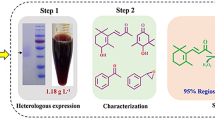Abstract
Human placental ribonuclease inhibitor (hRI) is an acidic protein of Mr∼50kDa with unusually high contents of leucine and cysteine residues. It is a cytosolic protein that protects cells from the adventitious invasion of pancreatic-type ribonuclease. hRI has 32 cysteine residues, and the oxidative formation of disulfide bonds from those cysteine residues is a rapid cooperative process that inactivates hRI. The most proximal cysteine residues in native hRI are two pairs that are adjacent in sequence. In the present aork, two molecules of alanine substituting for Cys328 and Cys329 were performed by site-directed mutagenesis. The site-mutated RI cDNA was constructed into plasmid pPIC9K and then transformed Pichia pastoris GS115 by electroporation. After colony screening, the bacterium was cultured and the product was purified with affinity chromatography. The affinity of the recombinant human RI with double site mutation was examined for RNase A and its anti-oxidative effect. Results indicated that there were not many changes in the affinity for RNase A detected when compared with the wild type of RI. But the capacity of anti-oxidative effect increased by 7∼9 times. The enhancement in anti-oxidative effect might be attributed to preventing the formation of disulfide bond between Cys328 and Cys329 and the three dimensional structure of RI was thereby maintained.
Similar content being viewed by others
References
Cregg J.-M, Madden K.-R., Barringer K.-J., Thill G.-P., Stillman C.-A., Function characterization of the two alcohol oxidase genes from the yeast Pichia pastoris, Mol. Cell Biol., 1989, 9: 1316–1323
Cregg J.-M. and Madden K.-J., Development of yeast transformation systems and construction of methanol-utilization-defective mutants of Pichia pastoris by gene disruption. In: Stewart G. G., Russell I., Klein R.-D. and Hiebsch R.-R. (eds.), Biological Research on Industrial Yeasts, Vol. 2, Boca Raton, FL: CRC Press, 1987, 1–18
Cui X.-Y., Fu P.-F., Pan D.-N., Zhao Y.-T., Zhao J., Zhao B.-C., The antioxidant effects of ribonuclease inhibitor, Free Rad. Res., 2003, 37(10): 1079–1082
Cui X.-Y., Structures and functions of ribonuclease inhibitor, Chemistry of Life, 1991, 11(3): 19–21[崔秀云, 核糖核酸酶抑制因子的结构和功能, 生命的化学, 1991,11(3): 19–21]
Fominaya J.-M. and Hofsteenge J., Inactivation of ribonuclease inhibitor by thiol-disulfide exchange, J. Biol. Chem., 1992, 267: 24655–24660
Hofsteenge J., Kieffer B., Matthies R., Hemmings B.-A., Stone S.-R., Amino acid sequence of the ribonuclease inhibitor from porcine liver reveals the presence of leucine-rich repeats, Biochemistry, 1988, 27: 8537–8544
Hofsteenge J., Ribonuclease inhibitor. In: D’Alessio G. and Riordan J.-F., (eds.), Ribonucleases: Structures and functions, New York: Academic Press, 1997, 621–658
Kim B.-M, Schu H.-Z.-L.-W., Kaines R.-I., Variants of ribonuclease inhibitor that resist oxidation, Protion Sci., 1999, 8(2): 430–434
Kobe B. and Deisenhofer J., Crystal structure of porcine ribonuclease inhibitor, a protein with leucine-rich repeats, Nat., 1993, 366: 751–756.
Lee F.-S., Fox E.-A., Zhou H.-M., Strydom D.-J., Vallee B.-L., Primary structure of human placental ribonuclease inhibitor, Biochemistry, 1988, 27: 8545–8553
Lee F.-S., Shapiro R., Vallee B.-L., Tight-binding inhibition of angiogenin and ribonuclease inhibitor, Biochemistry, 1989, 28: 225–230
Papageorgiou A.-C., Shapiro R., Acharya K.-R., Molecular recognition of human angiogenin by placental ribonuclease inhibitor, EMBO J., 1997, 16(17): 5162–5177
Peter B., Ribonuclease inhibitor from human placenta: rapid purification and assay, Biochemistry, 1979, 254(24): 12484–12487
Polakowski I.-J. and Lewis M.-K., Muthukkaruppan V., Erdman B., Kubai L. and Auerbach R., A ribonuclease inhibitor expresses anti-angiogenic properties and leads to reduced tumor growth in mice, Am. J. Pathol., 1993, 143: 507–517
Scherer G., Kramer M.-L, Schutkowski M., Reimer U., Fischer G., Barriers to rotation of secondary amide peptide bonds, J. Am. Chem. Soc., 1998, 120: 5568–5574
Shapiro R. and Vallee B.-L., Human placental ribonuclease inhibitor abolishes both angiogenic and ribonucleolytic activity of angiogenin, Proc. Natl. Acad. Sci. U.S.A., 1984, 84(8): 2238–2241
Turner R.-B. and Meador W.-R., Heats of hydrogenation. IV., Hydrogenation of some cis-and trans-cycloolefines, J. Am. Chem. Soc., 1957, 79: 4133–4136
Author information
Authors and Affiliations
Corresponding author
Additional information
__________
Translated from HEREDITAS, 2005, 27(2) [译自: 遗传,2005,27(2)]
Rights and permissions
About this article
Cite this article
Wu, Y., Cui, X., Wang, J. et al. Anti-oxidative effect of ribonuclease inhibitor by site-directed mutagenesis and expression in Pichia pastoris . Front. Biol. China 1, 99–103 (2006). https://doi.org/10.1007/s11515-006-0023-x
Issue Date:
DOI: https://doi.org/10.1007/s11515-006-0023-x




